These NCERT Solutions for Class 8 Science Chapter 15 Some Natural Phenomena Questions and Answers are prepared by our highly skilled subject experts to help students while preparing for their exams.
Some Natural Phenomena NCERT Solutions for Class 8 Science Chapter 15
Class 8 Science Chapter 15 Some Natural Phenomena Textbook Exercise Questions and Answers
Page-197
Select the correct option in Questions 1 and 2.
Question 1.
Which of the following cannot be charged easily by friction?
a. A plastic scale
b. A copper rod
c. An inflated balloon
d. A woollen cloth
Answer:
b. A copper rod
Question 2.
When a glass rod is rubbed with a piece of silk cloth the rod
a. and the cloth both acquire positive charge
b. becomes positively charged while the cloth has a negative charge
c. and the cloth both acquire negative charge
d. becomes negatively charged while the cloth has a positive charge
Answer:
b. becomes positively charged while the cloth has a negative charge
Question 3.
Write T against true and F against false in the following statements:
a. Like charges attract each other. (T/F)
b. A charged glass rod attracts a charged plastic straw. (T/F)
c. Lightning conductor cannot protect a building from lightning. (T/F)
d. Earthquakes can be predicted in advance. (T/F)
Answer:
a. F,
b. T,
c. F,
d. F
Question 4.
Sometimes, a crackling sound is heard while taking off a sweater during winters. Explain.
Answer:
When we take off a sweater, it rubs against our shirt. The rubbing together of sweater and shirt produces opposite electric charges on them. The discharge of these electric charges produces tiny sparks of light as well as crackling sound.

Question 5.
Explain why a charged body loses its charge if we touch it with our hand.
Answer:
Human body is a conductor of electricity. So, when we touch a charged object, our body conducts its charges to the earth. That is why a charged body loses its charge, if we touch it with our hand. This phenomenon is known as electric discharge.
Question 6.
Name the scale on which the destructive energy of an earthquake is measured. An earthquake measures 3 on this scale. Would it be recorded by a seismograph? Is it likely to cause much damage?
Answer:
The destructive energy of an earthquake is measured by the Richter scale. The reading of magnitude 3 on the Richter scale would be recorded by a seismograph. If the Richter scale gives a reading of magnitude 3, the earthquake is not likely to cause much damage. Generally, earthquakes having magnitudes higher than 7 are destructive in nature.
Question 7.
Suggest three measures to protect ourselves from lightning.
Answer:
Protective measures against lightning are as follows:
- Stay in a completely closed place. If you are moving in a car, remain there till the lightning is over. Close the windows of the car immediately.
- Do not touch any electrical wires, telephone cables, metal pipes, etc.
- Do not take a bath in running water. This may cause an electric shock.
Question 8.
Explain why a charged balloon is repelled by another charged balloon whereas an uncharged balloon is attracted by another charged balloon?
Answer:
We know that like charges repel each other. Since both the balloons carry similar charges, they are repelled by each other. But a charged balloon attracts an uncharged balloon because a charged object has a tendency to attract an uncharged object.
Question 9.
Describe with the help of a diagram an instrument which can be used to detect a charged body.
Answer:
An electroscope can be used to detect whether a body is charged or not. The figure given here shows a simple electroscope.
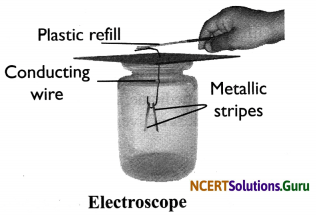
It consists of a metal rod. At one end of the rod, two leaves of aluminium foil are fixed and at the other end, there is a metal disc. The leaves of aluminium foil are placed inside a closed jar to isolate the leaves from air.
When the metal disc is touched with a charged body, the aluminium strips move away from each other. This happens because some of the charges of the body are transferred to the strips through the metal rod. The nature of charges on both the leaves is similar. Hence, both the leaves of the aluminium foil move away from each other. If, however, the body is not charged, the two leaves remain as they are and will not repel each other.

Question 10.
List three states in India where earthquakes are more likely to strike.
Answer:
The three states in India where earthquakes are more likely to strike are Jammu and Kashmir, Gujarat and Assam.
Question 11.
Suppose you are outside your home and an earthquake strikes. What precaution would you take to protect yourself?
Answer:
If we are out in the open and an earthquake strikes, we can take the following precautions:
- We should try to move away from buildings and other structures.
- If we are in a vehicle, we should ask the driver to drive slowly to a safe spot.
- We should keep away from bridges.
Question 12.
The weather department has predicted that a thunderstorm is likely to occur on a certain day. Suppose you have to go out on that day, would you carry an umbrella? Explain.
Answer:
If a thunderstorm is being predicted, we should not carry an umbrella. The metallic handle of an umbrella can be a potential target for lightning, and therefore, it is unsafe to carry an umbrella.
NCERT Extended Learning Activities and Projects
Question 1.
Open a water tap. Adjust the flow so that it forms a thin stream. Charge a refill. Bring it near the water stream. Observe what happens. Write a short report on the activity.
Hint:
Even if the water molecules as a whole are neutral, one of their ends is negatively charged while the other end is positively charged. Once the water molecule comes in contact with a charged object, it will get attracted towards it.
Question 2.
Make your own charge detector. Take a paper strip roughly 10 cm × 3 cm. Give it a shape as shown in the figure. Balance it on a needle. Bring a charged body near it. Observe what happens. Write a brief report, explaining its working.

Hint:
When a charged body is brought near it, it starts moving. When the charged body is rotated in a circular way, it also shows a circular motion.

Question 3.
This activity should be performed at night. Go to a room where there is a fluorescent tube light. Charge a balloon. Switch off the tube light so that the room is completely dark. Bring the charged balloon near the tube light. You should see a faint glow.
Move the balloon along the length of the tube and observe how the glow changes.
Caution: Do not touch the metal parts of the tube or the wires connecting the tube with the mains.
Hint:
When a charged balloon touches the tubelight, electrons pass from the balloon to the tubelight causing the bulb to emit small sparks of light. Under normal circumstances, the tubelight receives electrons from the electric power lines through a wire at the end of the tube.
Question 4.
Find out if there is an organisation in your area which provides relief to those suffering from natural disaster. Enquire about the type of help they render to the victims of earthquakes. Prepare a brief report on the problems of the earthquake victims.
Hint:
Students should find out about the organisations in their respective areas which provide relief to those suffering from a natural disaster. An earthquake
may cause damage and destruction to life and property. Roads and bridges collapse. Earthquake victims have to face deficiencies of food, water, security, medicine, fuel and so on, apart from the loss of lives of their loved ones.
Activity 1
Objective: To collect the different objects and charge them by rubbing.
Materials Required: Refill, balloon, eraser, steel spoon, coin, ball pen, polythene, woollen cloth, dry hair.
Procedure and Observations:
- Collect the different articles listed above and rub them with the objects as shown in the table given below.
- Try to attract small bits of paper with them and observe what happens in each case.
- Use insulating gloves while charging the metal spoon and coin.
Object rubbed | Material used for rubbing | Attract/ Does not attract bits of paper | A Charged/ Un charged |
| 1. Refill | Polythene, woollen cloth | Attracts | Charged |
| 2. Balloon | Polythene, woollen cloth, dry hair | Attracts | Charged |
| 3. Eraser | Wool | Attracts | Charged |
| 4. Steel spoon | Polythene, woollen cloth | Attracts | Charged |
| 5. Coin | Woollen cloth | Attracts | Charged |
| 6. Ball Pen | Hair | Attracts | Charged |
Conclusion: Objects can be charged by rubbing.
- Positive and Negative Charges: There are two types of charges namely positive charge and negative charge. Like charges repel each other while unlike charges attract each other.
- It is a convention to call the charge acquired by a glass rod when it is rubbed with silk as positive. The other kind of charge is said to be negative.

Activity 2
Objective: To show that like charges repel each other, whereas unlike charges attract each other.
Materials Required: Two glass rods, two ebonite rods, a piece of silk and a piece of fur.
Procedure:
- Rub a glass rod with a piece of siik and hang it with a thread (Fig. a).
- Rub another glass rod with a piece of silk and bring it near the suspended charged glass rod. See what happens.
- Rub an ebonite rod with a piece of fur and hang it with a thread (Fig. b).
- Rub another ebonite rod with a piece of fur and bring it near the suspended charged ebonite rod and observe.



Now perform similar activity by bringing a charged ebonite rod near a suspended charged glass rod (Fig. c).
Observation: Charged glass rod moves away s from another charged glass rod and charged ebonite rod moves away from another charged ebonite rod. But. a charged glass rod gets attracted towards a charged ebonite rod.
Conclusion: When the charges repel each other, they are like charges, and when the charges attract each other, they are unlike charges.
The electrical charges produced by rubbing are called static charges. When charges move, they constitute an electric current.
Transfer of Charge: Electric charge can be transferred from a charged object to another charged or uncharged object through a metal conductor.
Electroscope: It is a device that can be used to test whether an object is carrying any charge or not. An electroscope consists of two closely placed metallic (aluminium) foils or strips. When an electroscope is charged, its aluminium strips are diverged. If we touch the metal top of a charged electroscope with our finger, it gets discharged and its aluminum strips collapse. This is because the electric charge present on the charged electroscope flows to the earth through our hand and body. The electroscope loses all the electric charge, becomes uncharged and its diverged aluminium strips collapse.

Discharging: When a charged object loses its charge, it is said to be discharged. Earthing: When a charged object transfers its charge to the earth, it is called earthing. Generally, every building is provided with an earthing to protect it from electrical shocks due to leakage of electric current.
The Story of Lightning:
i. During the formation of a thunderstorm, the air currents move upward and the water droplets move downward. These vigorous movements result in separation of charges in the clouds.
ii. From these generated charges, the positive charges accumulate near the upper edges of the clouds and the negative charges accumulate near the lower edges of the clouds. Scientists are yet to understand the exact reason for this. There is an accumulation of positive charges near the ground also.
iii. When accumulation of charges becomes very large, the air which is a bad conductor of electricity under normal environment, is no longer able to resist their flow. As a result, the electric charges meet and produce streaks of bright light and sound across the sky. This process is called an electric discharge. It can occur between two or more clouds or between the clouds and the earth.

Dangers of Lightning: Lightning can damage houses and trees. It can also kill people and cattle.
Lightning Safety: One should not stay at an open place during lightning and thunderstorm. Hence as soon as we hear any alert about lightning or thunderstorm, we should rush to a safe place such as a house or a building. If somebody is there in a car or bus, they should stay inside and keep all the doors and windows closed. One should remain inside the safe place until the storm lasts.
Do’s and Don’ts during a Thunderstorm:
Outside the house-
- Open vehicles, like motorbikes, open cars, etc., are not safe.
- Open fields, tall trees, parks and elevated places are also not safe.
- Do not carry an umbrella during a thunderstorm.
- In a forest, take shelter under shorter trees.
- In an open field, stay away from trees, poles and other metal objects.
- Squat low on the ground, place your hands on your knees with your head between the hands. This will make you the smallest target to be hit.

Inside the house-
- Avoid contact with electrical switches and appliances.
- It is safer to use cell phones or cordless phones instead of a wired phone.
- Bathing should be avoided during thunderstorms to avoid contact with running water.
- Electrical appliances should be unplugged.
Lightning Conductor: This is a simple device which protects a building from the effect of lightning. It is composed of a vertical metallic rod which usually has a trident at the top and is taller than the building. The base of the metallic rod is attached to a thick metallic plate which goes very deep inside the earth. This metallic wire provides a passage for earthing. When lightning strikes, the electric charge goes to the lightning conductor which transfers it safely to the earth. Thus, a lightning conductor helps in preventing any damage to the building.
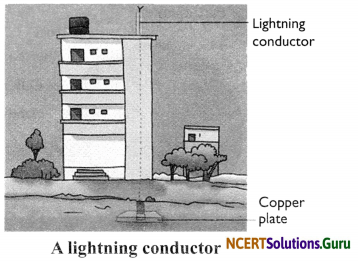
Earthquake: Sudden shaking of the earth which lasts for a very short duration is called earthquake. Earthquake can cause immense damage to buildings, dams, etc. They may also cause floods, landslides, tsunamis and loss of life.
A major earthquake occurred in India on 8 October 2005, in Uri and Tangdhar towns of North Kashmir. Before that, a major earthquake occurred on 26 January 2001, in Bhuj district of Gujarat.

Cause of an Earthquake: It is caused by a disturbance deep inside the earth’s crust. There are three layers of the earth-the outer crust, the middle mantle and the inner core. The outermost layer of the earth is not in one piece. It is fragmented and each fragment is called a plate or earth plate. These plates are in continuous motion. When these plates collide with one another, one plate goes under another plate which causes disturbance in the earth’s crust. Due to this disturbance, tremors take place in the form of earthquakes.

Seismic or Fault Zones: The earthquakes occur due to collision of plates. Therefore, the boundaries of plates are the weak zones where an earthquake is likely to occur. These week zones are called ‘Seismic zones’.
The places of seismic zones in India include Kashmir, Western and Central Himalayas, the whole North East, Great Rann of Kutch in the district of Gujarat, and some areas of South India.

Richter Scale: A scale which is used to determine the magnitude or strength of an earthquake is called the Richter scale. Destructive earthquakes have magnitude of more than 7 on a Richter scale.
Seismic Waves: The earthquakes produce tremors or waves on the surface of the earth, which are called seismic waves. These waves travel in all the directions on the earth’s surface.
Seismograph: A seismograph is an instrument which can record the seismic waves. It contains a metal rod or a pendulum which can vibrate as the earthquake occurs. The metal rod is attached to a pen which records the waves on the paper. Scientists study these waves and then construct a map of the earthquake. This also helps them in determining the power of the earthquake.

Protection against Earthquake: The buildings located in the seismic zones should be constructed in a way that they can handle major tremors. The following measures should be taken by the people to make the houses or buildings quake-safe:
- People should always consult architects and engineers before constructing a new building.
- The roofs of the building should be kept light.
- Timber or mud should be used in the construction of buildings rather than heavy materials.
- The shelves and cupboards should be fixed to the walls so that they do not fall off easily.
- Things such as photo frames, geysers, clocks and other wall hangings should be carefully placed so that they do not harm anybody if they fall off.
- Buildings should have firefighting equipment as earthquakes may cause fires.
- During the earthquake, one should take the following steps to protect oneself:
Inside the house:
- During earthquake, you should hide under a table. If you are in bed, keep a pillow over your head and do not move out of the bed.
- You should stay away from tall and heavy objects that may fall on you due to tremors.
- Stay away from tall and heavy objects that may fall on you.
Outside the house:
- In an open area, you should try to move away from buildings, trees, overhead power lines and other structures.
- If you are in a car or a bus, do not come out. Ask the driver to drive slowly to a clear spot. Do not come out till the tremors stop.
Class 8 Science Chapter 15 Some Natural Phenomena Additional Important Questions and Answers
Very Short Answer Type Questions
Question 1.
Name some destructive natural phenomena.
Answer:
Earthquake, lightning, cyclones, etc.
Question 2.
What is earthing?
Answer:
Transfer of charge from a charged body to the earth is called earthing.

Question 3.
What is the main purpose of providing earthing in buildings?
Answer:
To protect the building from electrical shocks due to any leakage of electrical current.
Question 4.
What is an earthquake?
Answer:
Sudden shaking of the earth, which lasts for a very short duration, is called an earthquake.
Question 5.
Name the place where major earthquake occurred in 2005 in India.
Answer:
Uri and Tangdhar towns of North Kashmir.
Question 6.
What is tectonic plate?
Answer:
The crust of the earth is composed of several pieces of landmass. These pieces are called tectonic plates.
Question 7.
What are seismic zones?
Answer:
The boundaries of the tectonic plates are at a high risk of earthquakes. These boundaries are called seismic zones or fault zones.
Question 8.
What is the magnitude of highly destructive earthquakes on Richter scale?
Answer:
Higher than 7.
Question 9.
Why is the charging by rubbing known as static electricity?
Answer:
Charging by rubbing is known as static electricity because the charges acquired by rubbing do not move.

Question 10.
Give the difference between static electricity and electric current?
Answer:
In static electricity, the charges do not move whereas in electric current, there is a flow of charges.
Question 11.
What causes a tsunami?
Answer:
An earthquake or volcanic activity occurring under the ocean causes a tsunami.
Question 12.
Name the three distinct layers of earth.
Answer:
The outer crust, the middle mantle and the inner core.
Question 13.
What are seismic waves?
Answer:
The tremors produce waves on the surface of the earth. These are called seismic waves.
Question 14.
What is hypocenter or focus?
Answer:
It is the point deep within the earth from where seismic waves originate.
Question 15.
What is focal depth?
Answer:
Focal depth is the vertical distance between the hypocenter (focus) and the epicenter of an earthquake.
Question 16.
What is an electric discharge?
Answer:
The process of meeting of negative and positive charges to release a huge amount of energy is called electric discharge.

Question 17.
What are the harmful effects of lightning on a lightning victim?
Answer:
Loss of memory, loss of sight or hearing, broken bones, etc.
Question 18.
What is Richter scale?
Answer:
This is a logarithmic scale which shows the intensity of an earthquake.
Short Answer Type Questions
Question 1.
What do you understand by charging by rubbing? Give suitable examples.
Answer:
Some objects get electrically charged when they are rubbed against one another. For example, when a plastic refill is rubbed with a polythene, both of them become charged.
Question 2.
Explain the structure of lightning conductor.
Answer:
This is a simple device which protects a building from the effects of lightning. It is composed of a vertical metallic rod which usually has a trident at the top. The base of the metallic rod is attached to thick metallic plate, which is buried very deep inside the earth. This metallic wire provides a passage for electric discharge in the earth.

Question 3.
Explain the structure of seismograph.
Answer:
Seismograph is a device which records the seismic waves. It is composed of an oscillator, a writing device and a roll of paper. The writing device is attached to the oscillator. In case of an earthquake, the oscillator begins to oscillate. This creates oscillation in the writing device, which plots wave-like patterns on the paper. The wave-like pattern is then analysed by seismologists to interpret the various features of an earthquake.
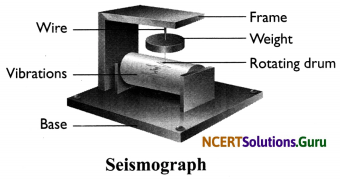
Question 4.
Why do we say that the Richter scale is not a linear scale?
Answer:
An instrument used to measure the magnitude or intensity of an earthquake is called Richter scale. The number indicating the magnitude or intensity on Richter scale usually ranges from 0 to 9 and above. The Richter scale is not a linear scale because on this scale, the vibrations of an earthquake with a magnitude of 2 are 10 times greater in amplitude than those of an earthquake with a magnitude of 1.

Question 5.
List three effects of an earthquake.
Answer:
The effects of earthquakes include deformation of ground surface, damage and destruction of human-made structures, destruction of towns and cities, loss of life, violent devastating fires, landslides, floods, etc.
Question 6.
Why does lightning usually strike tall buildings?
Answer:
Static electric charge is induced in tall buildings during lightning. Taller the buildings are, closer they are to the clouds and the charges flowing down from the sky. Charge induction happens more in closer objects than in faraway objects. Hence, lightning usually strikes tall buildings as they are the easy and quick targets.
Question 7.
What were the things used in Benjamin Franklin’s kite experiment?
Answer:
He flew a kite made of silk and a metal key tied to it during a thunderstorm. He got electric shock on touching the metal key. This proved that there are charges in the cloud.
Question 8.
Why are thunderstorms usually caused during summer?
Answer:
Thunderstorms are usually caused by the intense heating of the ground surface during summer. The warm air rises rapidly to form such clouds which accumulate electrical charges. These charges when discharged to the ground as flashes of lightning, cause heating of the air which comes in their path. This heated air expands rapidly, creating shock waves that are heard as a crash or rumble of thunder.
Question 9.
It is safer to use a wireless telephone rather than using a landline telephone during lightning. Explain the statement with the help of a reason.
Answer:
Lightning is a process of electrical discharge. During lightning, atmospheric charges may get discharged through landline telephone wires and may become dangerous. Therefore, it is safer to use a wireless telephone instead of a landline telephone during lightning.
Question 10.
Suggest some tips for a quake-safe building.
Answer:
Following provisions make a quake-safe building:
- Buildings should be made by consulting engineers and architects.
- Light-weighted materials should be used for making the buildings in earthquake-prone areas.
- Cupboards should be fixed to the walls so that they do not fall on someone during an earthquake.
- Proper installation of fire-fighting equipment should be ensured in buildings. Fire due to short circuit and gas leakage is quite common during an earthquake.

Question 11.
Explain the safety measures to be taken during a thunderstorm when you are inside your home.
Answer:
Safety measures to be taken during a thunderstorm when you are inside the house are as follows:
- Lightning can strike telephone cords, electrical wires and metal pipes. During a thunderstorm, contact with these should be avoided.
- Bathing should be avoided during thunderstorm to avoid contact with running water.
- Electrical appliances like computers, TVs, etc., should be unplugged. Electrical lights can remain on. They do not cause any harm.
Long Answer Type Questions
Question 1.
Explain the formation of lightning.
Answer:
Formation of lightning takes place in the following steps:
a. During a thunderstorm, the air currents move upward and water droplets move downward. These movements take place at a very fast pace, and it results in the separation of charges in the clouds.
b. The positive charges accumulate at the upper edges of the clouds and the negative charges accumulate at the lower edges of the clouds. Scientists are yet to understand the exact reason for this.
c. At the same time, the ground becomes positively charged.
d. Air is a bad conductor of electricity under normal circumstances. But when the amount of charge becomes too much in the clouds, the air is no more able to hold on to this charge. As a result, the electric charge is transferred to the ground. This appears as a bright streak of light across the sky, which lasts for a few seconds.

Question 2.
Mention some safety tips during lightning.
Answer:
Safety tips during lightning are as follows:
- No open place is safe during lightning, and hence a home or any other building is the safest place during lightning.
- The first sound of thunder is like a warning call for lightning. Hence, one should rush to a building soon after hearing a sound of thunder. One should come out of home only a few minutes after the last sound of thunder.
- You should not carry an umbrella (with a metallic handle) during a thunderstorm. Metallic handle can be a potential target for lightning.
- Tall trees and other tall structures are more prone to be hit by lightning. If you are caught in the open, try to hide under a short tree.
- If you are in open and have no place to hide, crouch on the ground and keep your head between your knees and hands.
- Do not take shower during lightning.
- Use of phone should be avoided during lightning.
- Television should be disconnected from the antenna.
- Avoid operating the electric switches and unplug all electrical gadgets during lightning.

Question 3.
List the steps you should take during an earthquake.
Answer:
Following are some steps you should take if you are caught in an earthquake:
- If trapped in your home or a building, take shelter under a table and do not move till the shaking stops. Protect your head with your arms. Avoid using a lift.
- Do not stay near the windows, bookcases, mirrors, hanging pots, fans, etc.
- Leave your home or school building and move to the open areas.
- If outdoors, keep away from high-rise buildings, trees, signboards, electric poles and electric wires.
- If you are in a car or a bus, do not come out. Ask the driver to drive slowly to a clear spot. Do not come out till the tremors stop.
Question 4.
Explain the mechanism by which earthquakes are caused.
Answer:
The tremors are caused by the disturbance deep down inside the uppermost layer of the earth called the crust. The earth’s crust is made up of several pieces of landmass. These are called tectonic plates. These plates are in continuous motion. When they brush past one another or one plate goes under the other due to collision, they cause vibrations in the earth’s crust. These vibrations occur as an earthquake on the surface of the earth.

Picture-Based Questions
Question 1.
Observe the figure given below and answer the following questions.
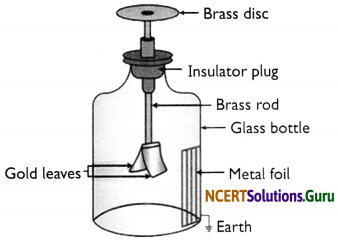
a. Name the device shown.
b. What is its use?
c. Do the metal leaves inside the jar acquire like or unlike charges?
d. Is it based on attraction or repulsion?
Answer:
a. Electroscope.
b. It is used to detect the presence or absence of charge on a body.
c. Like charges.
d. Repulsion.
Question 2.
Observe the given figure and answer the questions.
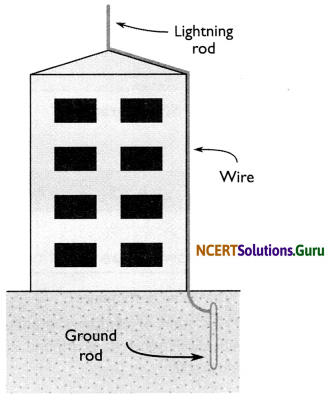
a. Name the setup shown here.
b. What is its purpose?
c. Can it be made of an insulating rod?
Answer:
a. Lightning conductor.
b. It is used to protect the building from the effects of lightning.
c. No.

Question 3.
Draw a labelled diagram of a seismograph.
Answer:


![]()



![]()

![]()

![]()


![]()

![]()











































